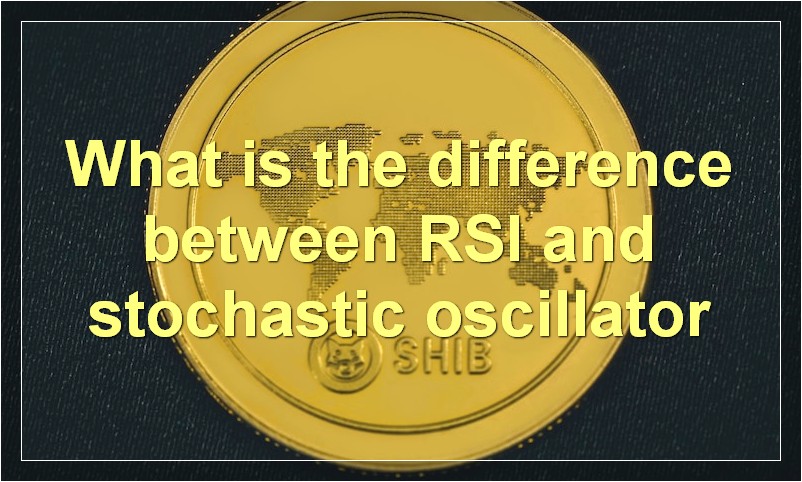If you’re interested in trading, then you’ve probably heard of the RSI indicator. But what is it and how can you use it?
what is rsi in stock market

RSI stands for Relative Strength Index. It is a technical indicator that measures the strength of a stock’s recent price performance. The RSI is calculated using a stock’s closing price over a certain period of time, typically 14 days. The RSI can be used to identify overbought or oversold conditions in the market, as well as to spot potential trend reversals.
How can I use RSI to trade stocks
RSI is a technical indicator that measures the magnitude of recent price changes to evaluate overbought or oversold conditions in the market. The RSI oscillates between 0 and 100. Traditionally, and according to Wilder, RSI is considered overbought when above 70 and oversold when below 30. Other traders use different levels to establish overbought (above 80) or oversold (below 20) conditions.
There are a couple of ways to trade stocks with RSI. One way is to buy when RSI moves below 30 and sell when it moves above 70. Another way is to buy when RSI moves above 50 and sell when it moves below 50.
Some traders like to wait for RSI to move out of overbought or oversold territory before entering a trade. Others like to wait for a confirmation signal, such as a bullish or bearish divergence, before entering a trade.
Once you have decided how you are going to use RSI, you need to decide what time frame you are going to use. Some traders use daily, weekly or monthly charts, while others use intraday charts.
Once you have selected your time frame, you can start looking for trading opportunities. When the RSI moves out of overbought or oversold territory, you can enter a trade in the direction of the trend. If you are using intraday charts, you can look for bullish or bearish divergences as a confirmation signal before entering a trade.
What is the best RSI indicator setting for day trading
There is no definitive answer to this question as different traders will have different opinions. Some may say that a shorter time frame is best, while others may argue that a longer time frame is better. Ultimately, it is up to the individual trader to experiment with different settings and see what works best for them.
Why does the RSI sometimes stay above 70 or below 30
The Relative Strength Index (RSI) is a momentum indicator that measures the magnitude of recent price changes to evaluate overbought or oversold conditions in the price of a stock or other asset. The RSI is displayed as an oscillator and its value ranges from 0 to 100.
The RSI is considered overbought when it rises above 70 and oversold when it falls below 30. These levels can be adjusted to suit the particular security or market being analyzed.
When the RSI is overbought, it means that the price has been rising too quickly and may be due for a correction. When the RSI is oversold, it means that the price has been falling too quickly and may be due for a rebound.
The RSI can stay above 70 or below 30 for extended periods of time in strong trends. However, if the RSI remains overbought or oversold for an extended period of time, it could be a sign that the trend is losing momentum and a reversal may be imminent.
What is the difference between RSI and stochastic oscillator

When it comes to technical analysis, there are a lot of different indicators out there that can be used to help you make better trading decisions. Two of the more popular indicators are the Relative Strength Index (RSI) and the Stochastic Oscillator. Both of these indicators can be used to identify overbought and oversold conditions, but they do so in different ways.
The RSI is a momentum indicator that measures the magnitude of recent price changes to evaluate overbought or oversold conditions. It is calculated using the following formula:
RSI = 100 – 100/(1 + RS)
RS = Average Gain / Average Loss
The Stochastic Oscillator is a momentum indicator that measures the location of the close relative to the high-low range over a set period of time. The indicator is calculated using the following formula:
%K = (Current Close – Lowest Low)/(Highest High – Lowest Low) * 100
%D = 3-day SMA of %K
As you can see, both indicators use different formulas to measure momentum. The RSI looks at the average gain and loss over a period of time, while the Stochastic Oscillator looks at the current close relative to the high-low range. Both indicators can be useful in identifying overbought and oversold conditions, but they should be used in conjunction with other technical analysis tools.
Is there a stock market predictor that uses RSI
There are a lot of different ways to predict the stock market, but one that is gaining in popularity is using RSI. RSI, or relative strength index, is a technical indicator that measures the magnitude of recent price changes to evaluate overbought or oversold conditions in the market. It is a widely used tool among traders and investors, and many believe that it can be helpful in predicting the stock market.
There are a few different ways to use RSI as a predictor. One way is to look at the overall trend of the RSI. If it is consistently above 70, it may be an indication that the market is overbought and could be due for a correction. On the other hand, if the RSI is consistently below 30, it may be an indication that the market is oversold and could be due for a rebound. Another way to use RSI as a predictor is to look for divergences. A divergence occurs when the price of a security is making new highs or lows, but the RSI is not. This can be an indication that the current price move is not sustainable and that a reversal may be coming.
While there is no guarantee that RSI will correctly predict every move in the stock market, it can be a helpful tool for those looking to make informed investment decisions.
Can I use RSI to find support and resistance levels in the stock market
Many traders use Relative Strength Index (RSI) to find potential support and resistance levels in the stock market. RSI is a momentum indicator that measures the magnitude of recent price changes to evaluate overbought or oversold conditions in the price of a stock. Generally, if the RSI value is above 70, it indicates that the stock is overbought, and if the value is below 30, it indicates that the stock is oversold. However, some traders also look for potential support and resistance levels when the RSI value is between 30 and 70.
What are some common mistakes traders make with RSI
One common mistake traders make with RSI is failing to account for the fact that it is a lagging indicator. This means that RSI will not signal a change in direction until after the price has already begun to move. As a result, traders may enter into a trade too late and miss out on some potential profits. Another mistake traders make is using RSI as a standalone indicator. While RSI can be a helpful tool, it should not be used in isolation. Instead, it should be combined with other technical indicators to form a complete trading strategy. Finally, some traders make the mistake of thinking that RSI always has to be between 30 and 70. While this is generally true, there are times when RSI canbreakout of this range, which can signal a change in the underlying trend.
How do I interpret RSI divergence
RSI divergence occurs when the RSI line diverges from the price line on a chart. This can be used to predict future price movements, as the RSI line is typically a good indicator of momentum. When the RSI line diverges from the price line, it means that the current momentum is not reflected in the price. This can be used as a signal to enter or exit a trade.

